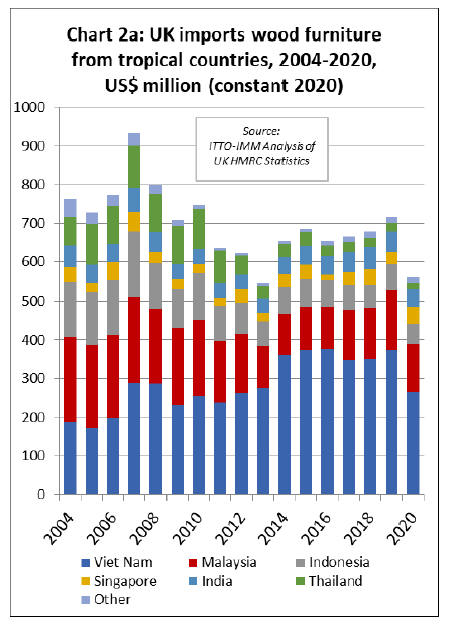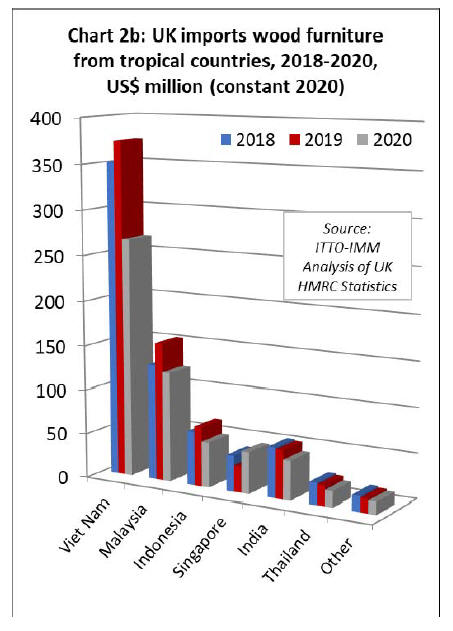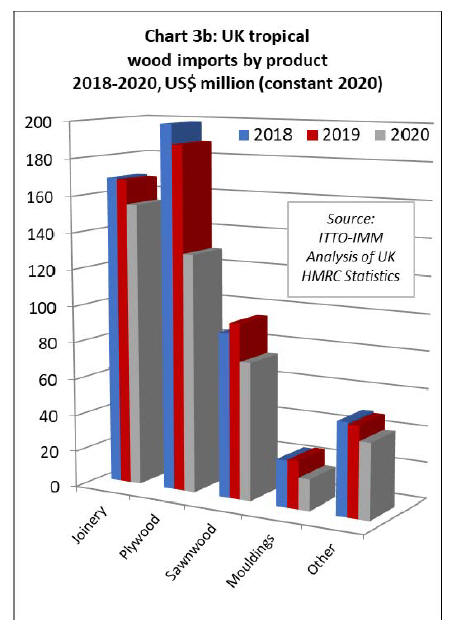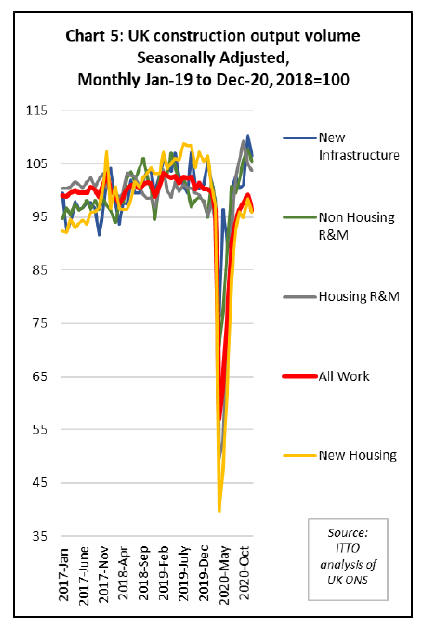|
Report from
Europe
Sharp fall in UK tropical wood imports in 2020 likely
to
be short-lived
Total UK tropical wood and wood furniture imports in
2020 were USD981 million, 23% less than the previous
year (Chart 1a). The UK being amongst the world¡¯s worst
affected countries by the COVID-19 pandemic last year, at
a time when there was already uncertainty due to the
country¡¯s departure from the EU, it is no surprise that
imports fell so precipitously.

The decline in UK imports of tropical wood and wood
furniture in 2020 was concentrated in May and June when
imports fell to around 50% of the normal level. After
recovering sharply between July and October, imports fell
5% to USD100 million in November and by a further 7%
to USD89 million in December (Chart 1b).

The slowdowns in 2020 coincided with the initial COVID-
19 lockdown in Q2 2020 and a second lockdown in Q4
2020 as another more severe wave of the virus hit in the
winter months.
A concern for tropical suppliers is that timber product
imports from tropical countries suffered a
disproportionately large share of the decline. There are,
however, reasons to believe that the downturn in the UK
market last year may be only temporary and that new
opportunities for tropical suppliers will open up in the
emerging post-Brexit trading environment.
The scale of the in 2020 downturn was strongly influenced
by supply side issues. UK demand for all wood products
has proved to be more resilient than expected during the
pandemic and importers are widely reporting that the main
obstacle to trade at present is lack of availability.
The problems of shipment and rising costs of freight have
been particularly intense from South East Asia, a factor
which should ease gradually as trade flows begin to
normalise this year.
While Brexit is likely to act as a significant drag on
economic recovery in the UK, at least in the short to
medium term, there are signs that the relatively thin trade
agreement reached between the UK and the EU in the
closing days of 2020 may help level the playing field for
non-EU wood suppliers in the UK market relative to EU
competitors.
This has particular significance for hardwood products
since the UK, unlike the rest of EU, has only a very
limited domestic hardwood resource, while the broader
wood processing and furniture manufacturing industries
are also relatively small in international terms.
The country has always been very heavily dependent on
imports for wood supply and now has a strong incentive to
build stronger trade links with countries outside the EU.
UK tropical wood furniture imports down 22% in 2020
Overall UK imports of wood furniture (HS 94) from
tropical countries in 2020 were USD562 million, 22% less
than in 2019. This was the lowest level since 2013 and
followed four years of consistent growth (Chart 2a).
UK imports from tropical countries fell much more than
imports from other countries in 2020. Total UK imports of
wood furniture fell 8% to USD 3.52 billion in 2020, with
imports from China down 7% to USD1.32 billion, down
5% from the EU to USD1.12 billion, and up 6% from
other non-tropical countries to USD458 million.

UK imports of wood furniture declined sharply from all
the leading tropical supply countries in 2020 (Chart 2b).
Imports from Vietnam were down 29% to USD267
million, imports from Malaysia fell 21% to USD123
million, imports from Indonesia declined 24% to USD51
million, imports from India fell 19% to USD44 million
and imports from Thailand were down 21% to USD18
million. In contrast, there was a 59% rise in imports from
Singapore to USD46 million.
The rise from Singapore is mainly due to logistics as large
container carriers left off the coast of Singapore during the
most stringent coronavirus measures in the second quarter
of 2020 re-entered the shipping market to help ship
containers to Europe.
Container space from other South Eastern countries was
very limited and was likely an important factor explaining
loss of share in the UK and wider European market for
wood furniture in 2020.

UK imports of tropical HS 44 wood products at
historically low level in 2020
UK imports of all tropical wood products in Chapter 44 of
the Harmonised System of product codes (excluding wood
for energy) declined 21% to USD417 million in 2020.
This is by far the lowest level since 2004, and probably for
many years prior to that (Chart 3a).

The downturn in imports of HS 44 wood products was
much greater from the tropics than other regions.
Total UK imports of HS 44 wood products from all
countries fell only 2% to USD5.02 billion in 2020. UK
imports from the EU actually increased 1.5% to USD3.35
billion in 2020, the gain partly explained by stock building
prior to the UK¡¯s exit from the single market on 31st
December 2020. Imports from China fell 6% to USD726
million while imports from other non-tropical countries
declined 4% to USD544 million.
In 2020, UK import value of all the main HS 44 tropical
wood product groups declined sharply, including tropical
joinery (-8% to USD155 million), tropical plywood (-31%
to USD130 million), tropical sawnwood (-22% to USD75
million), and tropical mouldings/decking (-35% to USD17
million) (Chart 3b).

UK hardwood market conditions unprecedented
According to the latest hardwood market report in the UK
Timber Trades Journal (http://www.ttjonline.com/), the
combined effect of COVID and Brexit has been to produce
unprecedented market conditions: ¡°Demand is reported as
good to exceptional, but the supply situation, particularly,
but not exclusively in North America, is proving
exceptionally challenging.
Prices are rising accordingly. While the sector reports
sales slumping to just 30-40% of normal levels at the
outset of the pandemic, since then, they have grown
exponentially. Some companies reported a seasonal dip in
December, others said they continued to climb and that
they hit the ground running in January¡±.
The TTJ highlights that that the surge in home
improvement is a key factor driving consumption, with
importers reporting high demand for anything to do with
construction, refurbishment and the garden and that
joinery customers are also flat out.
TTJ also notes that the hardwood supply situation is now
extremely tight as hardwood mills worldwide have
struggled to gear up production as markets emerge from
lockdown due to lack of raw material, social distancing
measures and a large proportion of personnel being in
isolation. Many mills have also been overly cautious about
increasing output, failing to forecast the huge surge in
global demand as China experienced a very rapid recovery
and the US and EU benefited from the home improvement
boom.
On tropical hardwoods, TTJ reports that while African
supply have been affected later and less than elsewhere by
the pandemic, implementation of Covid-safe work
practices has added to existing logistical problems and
very extended lead times. UK importers are saying that on
orders for kiln-dried African hardwood placed this
February, delivery is not expected before January 2022
delivery.
This highlights the extent to which UK importers are
having to rely on existing stockholdings and implies that
prices, which are already up 5% this year for sapele, the
most popular tropical hardwood species in the UK, will
continue to rise. Based on reports of very tight availability
from their suppliers in Cameroon, the Republic of the
Congo and Ghana, UK importers expect price pressure on
forward orders to increase.
One company told the TTJ that their Asian supply was
currently on hold due to ¡®off-the-chart¡¯ freight rate
increases resulting from the disruption to shipping and
particularly container distribution caused by the pandemic.
While a container from South East Asia cost US$1500 to
US$2000 a year ago, companies now report being quoted
US$12,000-$16,000.
According to TTJ, UK importers are still generally
reluctant to try alternative hardwoods despite the huge
supply and price pressure on preferred species like white
oak and sapele.
However, a few importers report that tiama is being used
as a sapele alternative, while there is steadily increasing,
but still very restricted, demand for angelim-vermelho,
angelim-amargoso, tatajuba, jutai and araracanga from
South America and eveus (Klainedoxa gabonensis) from
Africa. Amongst temperate species, American red oak has
made some gains as the price of white oak is now 40%
higher than it was a year ago.
UK GDP unlikely to recover to pre-pandemic level until
mid-2022
The UK government¡¯s official estimate is that GDP
contracted 9.9% in 2020, the biggest fall of any G7
country. The latest monthly data shows that the rebound in
UK GDP stalled in the last quarter of 2020 and continued
to decline in January 2021. The latest downturn coincides
with a return to lockdown to counter a second, more
severe, wave of the virus during the winter months.
As a result GDP in January 2021 was still over 9%
percentage points down compared to a year earlier The
UK government¡¯s latest forecast is for the economy to
rebound 4% this year and 7.3% in 2020. This means the
economy is unlikely to return to pre-pandemic levels
before the middle of 2022.
UK construction sector and builders¡¯ merchants report
strong growth
A positive factor for the UK timber trade in 2020 was that
the initial downturn in construction sector activity, which
is a key driver of timber demand, during the first ¡°great
lockdown¡± was short and followed by a stronger rebound
than other areas of the economy.
Although the rebound in UK construction lost momentum
in the last quarter of 2020, by the end of the year
construction activity in new infra-structure and repair and
maintenance, both for housing and non-housing, was
slightly higher than before the pandemic.
Activity in the new housing sector was only marginally
down on the pre-pandemic level (Chart 5). In January
2021, construction was the only main sector of the UK
economy to register growth, rising 0.9% compared to the
previous month.

Sales figures of UK builders¡¯ merchants follow the general
trend in construction. The BMF¡¯s Builders Merchants
Building Index (BMBI) reported a strong performance in
the third quarter of 2020 with sales returning to near
normal levels after the first Covid lockdown greatly
reduced sales in the second quarter.
This positive overall trend continued into the fourth
quarter, with total builders¡¯ merchants¡¯ sales 5.4% ahead
of the same period the previous year.
For the tropical hardwood sector, it is notable that the
fourth quarter year-on-year increase in merchant¡¯s sales
was driven by strong performances in Landscaping
(+22.9%) and Timber & Joinery (+12.7%). Concerted
efforts to build timber stocks at a time when supply was
low and prices high was a key factor behind the rise in the
value of trade during the period.
Taking 2020 as a whole, UK Builders Merchant¡¯s sales
were down by -10.7% compared to 2019. Given the
public¡¯s focus on their gardens during the first lockdown,
it is no surprise that Landscaping was the only category to
show an annual increase in sales value (+5.4%). In
contrast, sales for interior improvement were amongst the
worst performers including Kitchens & Bathrooms (-
18.1%) and Decorating (-16.5%).
BMF chief executive John Newcomb said: ¡°Given
widespread site closures both at the start of the pandemic
and for extended Christmas shut down periods, the
continued year-on year growth seen in the final quarter of
2020 provides a positive indicator of the building
industry¡¯s recovery. No doubt the Covid effect, including
its impact on product availability, will be felt for some
time to come.
But the adaptability to enforced changes demonstrated by
merchants and their trade customers over the past 12
months gives me a cautious degree of optimism for the
coming year.¡±
The extent to which material supply shortages are
impacting on the UK construction sector, due both to
COVID and the UK¡¯s departure from the EU single
market on 31st December, is highlighted in recent
comments on Brexit by Rico Wojtulewicz, the head of
housing and planning policy at the National Federation of
Builder: ¡®all materials from Europe are taking a while to
get into the UK, most with cost increases. Members are
having major issues with timber, such as MDF, veneers
and solid wood. There are very long wait times of two to
six months.¡¯
He added: ¡®Another issue having a major impact is the
availability and cost of shipping containers. In some cases,
the price per container has increased six-fold, in others
there just aren¡¯t any containers available.¡¯
Immediate trade impact as UK leaves the EU single
market
UK trade with the EU is now governed by the EU-UK
Trade and Cooperation Agreement concluded on 24th
December 2020 just a few days before the UK was due to
leave the single market at the end of the year. The
Agreement allows for zero tariff trade between the two
partners but does not exempt UK companies from the red
tape associated with a customs border, including the need
to handle customs declarations for imports and exports.
The UK tax office has estimated that British businesses
will spend £7.5 billion a year handling customs
declarations for trade with the EU ¡ª as much as they
would have done under a no-deal Brexit ¨C and has stated
that the number of customs forms needed to trade with the
EU under the Brexit deal ¡°is not materially different from
a no-deal situation¡±.
The effects on UK exports to the EU have been
immediate. A Road Haulage Association (RHA) member
survey found the volume of exports going through British
ports to the EU fell by 68% in January compared to the
same month last year, mostly as a result of problems
caused by Brexit.
While there has been a huge fall in UK exports to the EU
with the immediate introduction of EU customs controls to
UK products on 1st January, the situation in relation to UK
imports from the EU has been different.
UK imports from the EU have been affected by port
congestion and a shortage of freight capacity. However,
unlike the EU, the UK government chose a phased
approach to introduction of customs controls, postponing
the introduction of certain import procedures for EU
products.
These grace periods are designed to give businesses more
time to adapt to the new rules and ways of working.
The UK¡¯s initial intent was that requirements for
phytosanitary certification of UK imports from the EU
should be introduced from April while requirements for
full customs declarations on entering the UK market,
rather than submitting forms at a later date, should be
introduced from July.
However, on 11 March, the UK announced that these
grace periods would be extended for an extra six months
in a bid to give businesses and customs officials more time
to prepare for the additional red tape and to avoid the
threat of food shortages in the summer.
The move means the first checks on imports from the EU
into the UK will not start until October, with full border
controls not being carried out until 1 January 2022 ¨C a full
year after the UK left the EU.
These changes have significant implications for the UK
timber importing trade. In a typical year, the UK imports
around 9 million cubic metres of timber from Europe,
mostly softwoods and panel products, but including some
hardwood products, most notably oak sawnwood and birch
plywood.
Timber imported from the EU accounts for well over half
of all timber and panels consumed in the UK. In addition,
the UK imports wood furniture with a total value of
USD1.2 billion from the EU, around one third of all
imports and 15% of all consumption of wood furniture in
the UK.
Insights on the immediate effects of the UK¡¯s departure
from the EU single market on the UK timber importing
trade are provided in a TTF member survey published on
1st March. The survey draws on the views of thirty-six
respondents representing timber importers, merchants,
agents, and manufacturers.
In introducing the survey, the TTF note that, ¡°Q1 2021 has
already brought multiple reports of haulage and freight
companies rejecting jobs and hiking prices to travel to
Britain amid long waiting times at British ports¡±.
The survey suggests that the effects of Brexit on the UK
timber trade have been muted so far, particularly in the
hardwood sector. However, since border controls have yet
to be fully implemented, this may not be indicative of the
long term impact. The survey report finds that ¡°Brexit red
tape has caused a mild impact on their business as customs
and due diligence mapping combined with logistical
challenges from increased border checks has slowed down
trading, but not demand¡±.
Somewhat contradicting this conclusion, the survey report
also finds that ¡°Members have stated they are
experiencing a dramatic slowdown in deliveries,
particularly from haulage across the English Channel from
European countries¡±.
Where impacts are reported, they are a very much focused
on softwoods. While 66% of respondents stated they have
had ¡°logistics issues importing and exporting softwood
due to haulage companies charging increased rates,
rejecting their request for delivery in and out of the UK,
and a lack of truck ability due to the trade barriers
introduced by Brexit¡±, only 33% and 0% of respondents
stated these same issues had impacted on the hardwood
trade.
Similarly, new requirements for phytosanitary certificates
on UK imports from the EU had impacted on 33% of
hardwood traders compared to 66% of softwood traders.
A significant issue for many TTF members to date has
been growing obstacles to their trade with Northern
Ireland (NI). Although NI is a part of the UK, the region
also remains in the EU single market to prevent the
creation of a hard border between NI and the Irish
Republic and thereby protect the NI peace process.
The TTF survey report notes that ¡°while ¡®unfettered
access¡¯ from Great Britain to Northern Ireland had been
promised, in reality trading has become more difficult,
with a number of our members reporting they are looking
to cease trading with Northern Ireland until the trade
barriers are removed¡±.
The TTF also notes that new requirements for UKCA
marking are starting to concern members. ¡°While this year
members can continue placing CE-marked goods onto the
UK market, from January 2022 the UKCA mark will
become the sole UK conformance mark. This would raise
considerable trade barriers and challenges next year with
concerns businesses will not have enough time to prepare
for the implementation of the new mark.
The TTF has announced that it ¡°will work with the
Construction Products Association (CPA) and the
Confederations of Business Industries (CBI) to advocate
for a deferment of the implementation of the mark or to
achieve equivalence with the CE Mark¡±.
EU exporters struggle to respond to UK due diligence
requests
One measure already enforced in the UK is the UK
Timber Regulation which imposes legality due diligence
requirements on all timber products placed on the UK
market, including from the EU, and which replaces the
EUTR. The TTF survey suggests that this is a "mild
barrier" to TTF members trade with the EU and Northern
Ireland.
According to the TTF, importing timber from the EU has
been made more difficult as ¡°European companies
unwilling or unable to share details of supply chains to
help members complete the necessary due diligence has
become a growing problem.¡±
Furthermore, ¡°each shipment must go through double due
diligence. Stock going into the EU undergoes due
diligence and then when it has been purchased by a UK
trader, due diligence on the same product has to be
undertaken again¡±.
One respondent to the TTF survey stated ¡°Due diligence
works for bulk supplies from regular customers outside the
EU. But when topping up from the EU, there could be
several supply chains involved in one shipment. Every
chain has to be risk assessed despite already being risk
assessed to enter the EU.
Suppliers do not want to risk revealing their supply chains
for smaller (but essential) occasional orders.¡±
Some respondents to the survey highlighted that European
suppliers do not understand why they have to prove due
diligence when the product is certified or when from a
low-risk region of the EU. TTF note that ¡°it is hoped that
over time our members¡¯ European suppliers will accept
the new due diligence requirements and share their supply
chain information to lessen the blocking of trade¡±.
In response to Brexit, Vandecasteele Houtimport, the large
Belgian hardwood importer, has created a UK registered
company to minimise post-Brexit administration and
streamline service for customers. Vandecasteele Timber
Ltd acts as operator under the UK Timber Regulation,
handling all due diligence and other customs clearance
procedures.
¡°We have set up the company basically to continue to
service the UK market as before,¡± said export manager
Genevi¨¨ve Standaert. ¡°It ensures for UK customers that
nothing changes; all paperwork is from UK to UK, so
there are no headaches for customs clearance,
phytosanitary certificates, VAT prepayment and so on.
Due diligence, in particular, can be a lot of work and a
challenge for companies which may not have done it
before. We take that work on on the UK customer¡¯s
behalf.¡±
Vandecasteele¡¯s sales to the UK dropped sharply in the
first two months of the pandemic but recovered rapidly
from May. ¡°Business has continued to grow since and
today is really good,¡± said Ms Standaert.
|